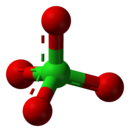Perchlorates
 |
|||
|
|
|||
| Names | |||
|---|---|---|---|
|
Systematic IUPAC name
Perchlorate
|
|||
| Identifiers | |||
|
3D model (Jmol)
|
|||
| ChEBI | |||
| ChemSpider | |||
| DrugBank | |||
| ECHA InfoCard | 100.152.366 | ||
| 2136 | |||
| MeSH | 180053 | ||
|
PubChem CID
|
|||
|
|||
|
|||
| Properties | |||
| ClO− 4 |
|||
| Molar mass | 99.451 g mol−1 | ||
|
Except where otherwise noted, data are given for materials in their standard state (at 25 °C [77 °F], 100 kPa).
|
|||
|
|
|||
| Infobox references | |||
Perchlorates are the salts derived from perchloric acid—in particular when referencing the polyatomic anions found in solution, perchlorate is often written with the formula ClO−
4. Though produced by natural processes, the preponderance of perchlorates on Earth are produced commercially. Perchlorate salts are mainly used for propellants, exploiting properties as powerful oxidizing agents. Perchlorate contamination in the environment has been extensively studied as it has effects on human health. Perchlorate has been linked to its negative influence on the thyroid gland.
Most perchlorates are colorless solids that are soluble in water. Potassium perchlorate has the lowest solubility of any alkali metal perchlorate (1.5 g in 100 ml of water at 25 °C). Four perchlorates are of primary commercial interest: ammonium perchlorate (NH4ClO4), perchloric acid (HClO4), potassium perchlorate (KClO4), and sodium perchlorate (NaClO4). Perchlorate is the anion resulting from the dissociation of perchloric acid and its salts upon their dissolution in water. Perchlorate salts are soluble in water and dissociate into the perchlorate anion and the cation from the salt. Because perchlorate salts are readily soluble in both aqueous and non-aqueous solutions, when these salts are solvated, especially ammonium perchlorate, they can undergo redox reactions and release gaseous products and contaminate water and soil.
Perchlorate salts are produced industrially by the oxidation of solutions of sodium chlorate by electrolysis. This method is used to prepare sodium perchlorate. The main application is for rocket fuel. The reaction of perchloric acid with bases, such as ammonium hydroxide give salts. The highly valued ammonium perchlorate can be produced electrochemically.
...
Wikipedia


